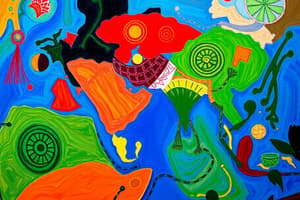Podcast
Questions and Answers
What was the main trade crop from the forest areas in the wet zone during the period mentioned?
What was the main trade crop from the forest areas in the wet zone during the period mentioned?
- Aricanuts
- Cinnamon (correct)
- Nutmeg
- Cardamom
In what year did the Arab traveler Iban Batuta visit Sri Lanka and make records about the rich trading in harbors?
In what year did the Arab traveler Iban Batuta visit Sri Lanka and make records about the rich trading in harbors?
- 1344 A.D. (correct)
- 1402 A.D.
- 1498 A.D.
- 1256 A.D.
Which country did Sri Lanka have trade relations with during the period mentioned?
Which country did Sri Lanka have trade relations with during the period mentioned?
- India, Arab, China, Persia, Egypt (correct)
- Canada, Brazil, Mexico
- Russia, Japan, Australia
- Germany, France, Spain
What archaeological evidence found in Dedigama reveals an import from China?
What archaeological evidence found in Dedigama reveals an import from China?
During the second urbanization period, which religion grew as the main religion?
During the second urbanization period, which religion grew as the main religion?
Who acted to build palaces for the sacred Tooth relic and construct many temples and monasteries during the mentioned periods?
Who acted to build palaces for the sacred Tooth relic and construct many temples and monasteries during the mentioned periods?
What was the impact of Arab traders taking control of international trade in the Indian Ocean after the 6th century A.D.?
What was the impact of Arab traders taking control of international trade in the Indian Ocean after the 6th century A.D.?
What geographical region became the center of international trade in the Indian Ocean after the 6th century A.D.?
What geographical region became the center of international trade in the Indian Ocean after the 6th century A.D.?
How did the trade focus shift in the Indian Ocean after the 9th century A.D.?
How did the trade focus shift in the Indian Ocean after the 9th century A.D.?
Why did King Vijayabahu I choose Polonnaruwa as his ruling center according to the text?
Why did King Vijayabahu I choose Polonnaruwa as his ruling center according to the text?
What threat did Sri Lanka aim to prevent by activating ports and establishing a city close to the coastal area?
What threat did Sri Lanka aim to prevent by activating ports and establishing a city close to the coastal area?
How did Arab traders impact international trade in the Indian Ocean post-6th century A.D.?
How did Arab traders impact international trade in the Indian Ocean post-6th century A.D.?
Who was the founder of the Jaffna kingdom?
Who was the founder of the Jaffna kingdom?
In which year did the Portuguese arrive in the country during the ruling time of the Jaffna kingdom?
In which year did the Portuguese arrive in the country during the ruling time of the Jaffna kingdom?
Who sent Prince Sapumal to bring Jaffna under the Kotte kingdom?
Who sent Prince Sapumal to bring Jaffna under the Kotte kingdom?
Which minister acted against the representatives of Arya Chakravarthi who collected taxes in areas belonging to the Gampola kingdom?
Which minister acted against the representatives of Arya Chakravarthi who collected taxes in areas belonging to the Gampola kingdom?
During which period did the Jaffna area loosen from the grip of Kotte after King Parakramabahu VI?
During which period did the Jaffna area loosen from the grip of Kotte after King Parakramabahu VI?
What weakened the ruling over the Jaffna area from Kotte's grip?
What weakened the ruling over the Jaffna area from Kotte's grip?
Flashcards are hidden until you start studying
Study Notes
- After the 6th century A.D., Arab traders took control of international trade in the Indian Ocean, particularly in the Western part.
- The geographical center of trade shifted to the Eastern part of the Indian Ocean by the 9th century.
- Sri Lanka, with its strategic location, recognized the importance of activating Eastern coast ports and ruling nearby.
- The country had a surplus of food crops and exported cinnamon, arecanuts, cardamom, nutmeg, pepper, pearls, gems, tuskers, and tusks to India, Arab, China, Persia, and Egypt.
- The international trade led to a commercial economy, and the ruling monarch held a monopoly over the trade.
- Buddhism became the dominant religion during the second urbanization period, with many palaces, temples, and monasteries built.
- The Jaffna kingdom emerged after the downfall of the Rajarata civilization, with the founder, Vijay Kulankeyi Arya Chakravarthi, ruling from the 15th century.
- The Jaffna kingdom was later brought under the Kotte kingdom but regained independence afterward.
- The Arya Chakravarthi dynasty ruled the Jaffna kingdom, with notable rulers such as Kulashekara, Vikkirama, Varodaya, and Marthanda.
- Ibn Batuta, an Arab traveler, visited Sri Lanka in 1344 and reported a rich trading scene in the Western coasts.
- The ruling unit in Jaffna during the second urbanization period is known as the Jaffna kingdom, with historical records dating back to the 18th century.
- The Portuguese arrived in Sri Lanka during the rule of Arya Chakravarthi, leading to the end of the Jaffna kingdom's independence.
Studying That Suits You
Use AI to generate personalized quizzes and flashcards to suit your learning preferences.



